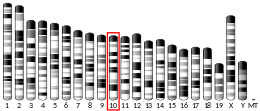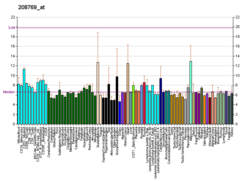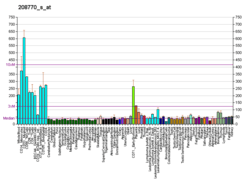EIF4EBP2
Eukaryotic translation initiation factor 4E-binding protein 2 is a protein that in humans is encoded by the EIF4EBP2 gene.[5][6][7]
Animal studies
EIF4EBP2 knockout mice have been used as an animal model of autism. Mice without the Eif4ebp2 gene exhibited autism-like symptoms, including poor social interaction, altered communication and repetitive behaviors. Knockout mice have high levels of Neuroligins.[8]
Interactions
EIF4EBP2 has been shown to interact with EIF4E.[5][9]
gollark: How long did the testing take? If it was a long one, then I'd expect the desktop CPU to do better because of thermal throttling.
gollark: The i7 probably has better IPC, and there are lots of diminishing returns with clock speed.
gollark: At least JS has a sort of working package manager.
gollark: All hail Javascript!
gollark: Oh, just "hold its own", not "actually do better", right.
References
- GRCh38: Ensembl release 89: ENSG00000148730 - Ensembl, May 2017
- GRCm38: Ensembl release 89: ENSMUSG00000020091 - Ensembl, May 2017
- "Human PubMed Reference:". National Center for Biotechnology Information, U.S. National Library of Medicine.
- "Mouse PubMed Reference:". National Center for Biotechnology Information, U.S. National Library of Medicine.
- Pause A, Belsham GJ, Gingras AC, Donzé O, Lin TA, Lawrence JC, Sonenberg N (October 1994). "Insulin-dependent stimulation of protein synthesis by phosphorylation of a regulator of 5'-cap function". Nature. 371 (6500): 762–7. doi:10.1038/371762a0. PMID 7935836.
- Tsukiyama-Kohara K, Vidal SM, Gingras AC, Glover TW, Hanash SM, Heng H, Sonenberg N (December 1996). "Tissue distribution, genomic structure, and chromosome mapping of mouse and human eukaryotic initiation factor 4E-binding proteins 1 and 2". Genomics. 38 (3): 353–63. doi:10.1006/geno.1996.0638. PMID 8975712.
- "Entrez Gene: EIF4EBP2 eukaryotic translation initiation factor 4E binding protein 2".
- Gkogkas CG, Khoutorsky A, Ran I, Rampakakis E, Nevarko T, Weatherill DB, Vasuta C, Yee S, Truitt M, Dallaire P, Major F, Lasko P, Ruggero D, Nader K, Lacaille JC, Sonenberg N (January 2013). "Autism-related deficits via dysregulated eIF4E-dependent translational control". Nature. 493 (7432): 371–7. doi:10.1038/nature11628. PMC 4133997. PMID 23172145. Lay summary – Nature Magazine.
- Mader S, Lee H, Pause A, Sonenberg N (September 1995). "The translation initiation factor eIF-4E binds to a common motif shared by the translation factor eIF-4 gamma and the translational repressors 4E-binding proteins". Molecular and Cellular Biology. 15 (9): 4990–7. doi:10.1128/mcb.15.9.4990. PMC 230746. PMID 7651417.
Further reading
- Lin TA, Lawrence JC (November 1996). "Control of the translational regulators PHAS-I and PHAS-II by insulin and cAMP in 3T3-L1 adipocytes". The Journal of Biological Chemistry. 271 (47): 30199–204. doi:10.1074/jbc.271.47.30199. PMID 8939971.
- Dilling MB, Germain GS, Dudkin L, Jayaraman AL, Zhang X, Harwood FC, Houghton PJ (April 2002). "4E-binding proteins, the suppressors of eukaryotic initiation factor 4E, are down-regulated in cells with acquired or intrinsic resistance to rapamycin". The Journal of Biological Chemistry. 277 (16): 13907–17. doi:10.1074/jbc.M110782200. PMID 11847216.
- Shenberger JS, Adams MH, Zimmer SG (August 2002). "Oxidant-induced hypertrophy of A549 cells is accompanied by alterations in eukaryotic translation initiation factor 4E and 4E-binding protein-1". American Journal of Respiratory Cell and Molecular Biology. 27 (2): 250–6. doi:10.1165/ajrcmb.27.2.4785. PMID 12151318.
- Ferguson G, Mothe-Satney I, Lawrence JC (November 2003). "Ser-64 and Ser-111 in PHAS-I are dispensable for insulin-stimulated dissociation from eIF4E". The Journal of Biological Chemistry. 278 (48): 47459–65. doi:10.1074/jbc.M307949200. PMID 14507920.
- Joshi B, Cameron A, Jagus R (June 2004). "Characterization of mammalian eIF4E-family members". European Journal of Biochemistry. 271 (11): 2189–203. doi:10.1111/j.1432-1033.2004.04149.x. PMID 15153109.
- Rual JF, Venkatesan K, Hao T, Hirozane-Kishikawa T, Dricot A, Li N, Berriz GF, Gibbons FD, Dreze M, Ayivi-Guedehoussou N, Klitgord N, Simon C, Boxem M, Milstein S, Rosenberg J, Goldberg DS, Zhang LV, Wong SL, Franklin G, Li S, Albala JS, Lim J, Fraughton C, Llamosas E, Cevik S, Bex C, Lamesch P, Sikorski RS, Vandenhaute J, Zoghbi HY, Smolyar A, Bosak S, Sequerra R, Doucette-Stamm L, Cusick ME, Hill DE, Roth FP, Vidal M (October 2005). "Towards a proteome-scale map of the human protein-protein interaction network". Nature. 437 (7062): 1173–8. doi:10.1038/nature04209. PMID 16189514.
This article is issued from Wikipedia. The text is licensed under Creative Commons - Attribution - Sharealike. Additional terms may apply for the media files.





